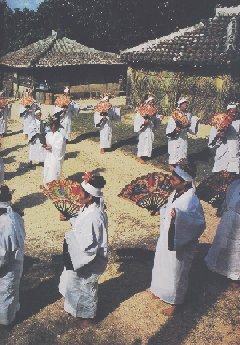 IZAIHO in Kudaka-jima Island, Okinawa 1978 photo: HIGA
Yasuo
IZAIHO in Kudaka-jima Island, Okinawa 1978 photo: HIGA
Yasuo
 IZAIHO in Kudaka-jima Island, Okinawa 1978 photo: HIGA
Yasuo
IZAIHO in Kudaka-jima Island, Okinawa 1978 photo: HIGA
Yasuo
TokyoCinema's activity in this field began
from early 50-ies. Founder of TokyoCinema,
OKADA Sozo got big influence from SHIBUSAWA
Keizo, one of initiator of Ethnology and
Folklore studies in Japan in his youth period.
Sozo met various researchers through SHIBUSAWA's
soroundings. After the WW2, he participated
as a trustee of SHIBUSAWA's Japan Common
People's Culture Institute. OKADA Sozo selected
his profession as a cinematographer, when
he saw R. Fraherty's NANOOK OF THE NORTH
while the film was shown in Paris early 20-ies.
In the middle of 50-ies, when Eastmancolor
negative became populer in Japan, newly started
TokyoCinema intensively began to record fermer's
life and traditional culture in province.
From the 70-ies, when began activities of EC Japan Archives, TokyoCinema tried to build up the new style of documentation in moving images in folklore and Japanese traditional culture. The first break through was filming of the Gagaku series. TokyoCinema practicised multi-camera filming and this experiences polished at the recording of IZAIHO and other documentation in the joint project with many scientists and specialist in the field of performing art study, traditional rites, etc.
TokyoCinema's activities through Encyclopaedia Cinematographica, made possible us to access huge amount of ethnographic films and utilize them. As the results, TokyoCinema together with ECJA re-edited more than 50 titles of the videotheque softwares for NME = the National Museum of Ethnology in Osaka.
TokyoCinema's strong desire is to fulfill the empty spot of those world. One of the white area for the world ethnography was Soviet Siberia and Central Asia. TokyoCinema is continuing gather audio and visual information concerning to these areas. Also TokyoCinema is supporting film−makers working in these area.
TokyoCinema participated to the formation of CRUMIM , a specialized company for service to museums, supporting publication of news letter "Moving Images in Museum" discussed how should be made visual documentation of cultural heritages. Those studies are utilized also on our own productions like, 100 SELECTED SOUND SCAPES OF JAPAN or new edition of GAGAKU series by the musicians and dancers at the imperial palace, Tokyo..
1998.09.20. started Bilingual page
2000.04.10. started English page